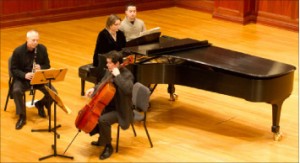
By Eman Hassan
Correspondent
Complete silence ruled during the musical numbers. Audience members widened their eyes, relaxed their muscles and sighed as music drifted through the Mildred and Ernest E. Mayo Concert Hall. Perhaps these were side effects of Robert Schumann’s classical masterpieces.
This serene atmosphere was achieved during the Romantic Chamber Music Brown Bag Series.
According to John Laughton, clarinetist and dean of the School of Arts and Communications, the Schumann pieces performed on Thursday, Feb. 10, are “a sound representation of life during (the 1800s).”
“There was the creation of the Eiffel tower and an internationalizing of the culture,” Laughton said.
He performed three different Schumann pieces alongside cellist Stephen Framil and pianist Michal Schmidt.
The first song began as a foreboding clash of aggressive piano keys and cello strokes. After the song’s first movement, though, its angry chords dissolved into a peaceful, romantic melody.
Musicians seemed to share a special bond with their instruments. At times, they closed their eyes while playing.
“Making music and creating art is all about relationships,” Laughton said before the first number. “Even though we are musicians, we stand behind these instruments with Ph.Ds.”
These musicians and teachers played in perfect unison, which took a lot of practice.
“In preparation for a concert, a group needs a few hours to work together, depending on the demands of the piece,” Schmidt said. “Each player spends his or her own time learning their part, and then the rehearsals are used for playing together and arriving at a common interpretation of the piece.”
Schmidt hopes that practicing will refine the trio’s musicianship so they can do justice to the multilayered piece.
“In my view, ‘The Brahms Trio’ has elements of tenderness, calmness, emotional strength and some sadness. It is a beautiful piece that was written by an old composer who has seen and experienced life,” Schmidt said.
The instruments’ soft serenades seemed to tell the old composer’s story.
After the performance, music professor John Leonard sang three of Schumann’s songs in German. He reminded the audience that the key element in these songs is the “unification of piano and voice.”
One of the songs, “Beautiful Cradle of My Sorrows, Op. 24, No. 2.” derived its lyrics from German romantic poetry. Translated, one verse reads, “Farewell, you holy threshold / Across which my darling would tread / Farewell! You sacred spot where I first saw her.”
Schmidt discussed classical music’s enduring importance in a time when it is sometimes forgotten — after all, it’s quite unlikely that we’ll hear Schumann on the Z100 Hitlist alongside Lady Gaga and Katy Perry.
“Classical music has the aesthetics of discipline and beauty. It can have different styles and sounds, but the work that goes into composing and performing it is work that is worth spending time on,” Schmidt said.
This music was composed before there were recording studios, microphones or DJ spin sets. Each note had to be carefully transcribed, written and rehearsed. Schmidt proposes that the arduous composition process holds a significant lesson for modern musicians.
“It teaches us ways to think, to delve deep into our own emotions, to find out what the composer’s ideas were, how to make them real and bring them to an audience in a way that will be interesting and true,” Schmidt said.






